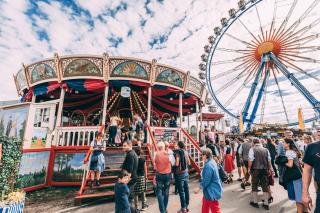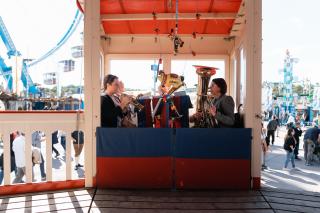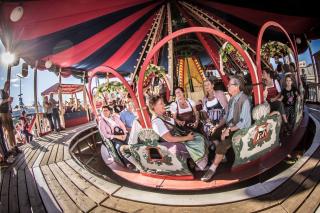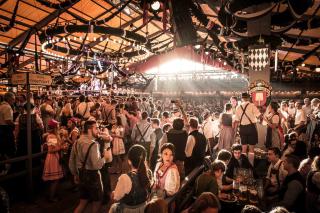Nostalgic riding fun with brass music: The Krinoline
The Krinoline (Crinoline) promises nostalgic riding fun with its own brass band. If you’ve never gone for a ride, you’re missing out.

What’s special: a journey back in time to the twenties
Krinoline rides were a popular attraction at the beginning of the 20th century. Today, the Krinoline is the last original of its kind at the Munich Oktoberfest. If you want to experience the nostalgic riding pleasure, you have to come to the Wiesn. Compared to the modern rides to the left and right of the Krinoline, it seems more leisurely. Times have changed since the ride was first built on the Theresienwiese in 1924. Back then, it took three to four men to get the Krinoline going. It wasn’t until 1936 that operator Michael Großmann began to move the sofa gondolas electrically. However, the maximum speed doesn’t exceed 15 km/h. Already in the thirties, faster and more modern rides were enticing visitors away. To make the Krinoline more attractive again, Großmann relied on a brass band, for which he added a small balcony. Since 1938, the band has provided a special riding pleasure with traditional brass music.

The Krinoline: for everyone who likes it comfortable
Who should ride the Krinoline? The answer: everyone, big and small! Everyone who likes it comfortable will get their money’s worth on this ride. But so will everyone else, because the riding fun has tradition, and it just wouldn’t be a Wiesn visit without it. The leisurely ride invites you to chat and the brass music provides the right “Krinoline feeling.” The sixteen sofa gondolas swing under a red and blue striped tent on a mast decorated with Art Nouveau paintings and strings of lights. When the ride begins in the Krinoline, the moment is almost magical. Long live nostalgia.

Krinoline for backseat drivers: like a hoop skirt
When the Krinoline turns, it is reminiscent of a hoop skirt worn by 19th-century women under their dance dresses. So the name doesn’t just come from chance, because the term “crinoline” stands for a special kind of hoop skirt, which often provided for the extensive width of clothes, constructed from spring steel bands. When the women danced, the hoop skirt swung - as do the gondolas of the Krinoline.

